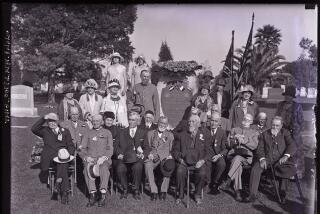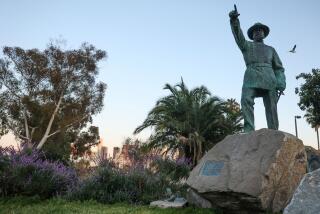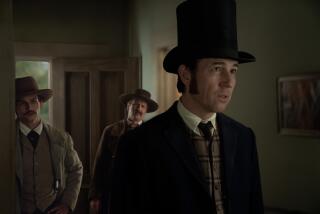In Memory of the Face You See on Our $5 Bill
If it’s February, this must be Redlands. Home of the only Lincoln memorial west of the Mississippi.
We are met at the Lincoln Memorial Shrine by a man in a gray flannel suit wielding a Civil War sword. He is surrounded by a group of grade-schoolers for whom that long-ago war is only as real as a rented video.
Meet Don McCue. Seven years ago, he answered a help-wanted ad in a newspaper and wound up here as curator. Quite honestly, he says, he was no Lincoln scholar, having trained for a career in the foreign service.
But, having now read dozens of books in the shrine’s 3,000-volume collection and having fielded questions on everything from Mrs. Lincoln’s sanity to Abe Lincoln’s love life, McCue has more than a passing acquaintance with our 16th President.
A few of his observations:
* On Mary Todd Lincoln: “She faced a lot of what Hillary Clinton is facing. Women weren’t supposed to be involved in politics in those days. There was a backlash: Here was this uppity woman poking her nose in places she didn’t belong.”
* On Lincoln as pragmatist: “We have this image of Honest Abe, but he knew how to roll logs and scratch backs. He was the consummate politician.”
McCue points to one of 15 signed Lincoln letters at the shrine. Lincoln is granting a discharge to a soldier facing court martial for deserting after the battle of Antietam. Lincoln was facing reelection--and the soldier’s father happened to be an influential judge in a vote-rich state.
* On Lincoln-bashing by those who point out that his overriding goal was to save the Union, not to emancipate the slaves, nor to gain equality for them: “Some of that is justified . . . but there is a temptation to impose 1990s standards on the 1860s.”
As curator and sometime tour guide of this jewel box museum/library/research facility, McCue, 36, winces when confronted by schoolchildren who don’t know what slavery was and recognize Lincoln only as the face on a $5 bill.
But he’s prepared for the callers who ask:
“Is it true that Lincoln was killed by the Jesuits?” (A theory advanced in the 1880s by an ex-priest who saw a conspiracy with the Pope to eliminate Lincoln and make America a Catholic country.)
“Is it true that my great-great-great grandfather was a drinking buddy of Lincoln after he was jilted by Ann Rutledge?” (Probably not. Since the PBS series, “The Civil War,” in 1990, family tree queries have abounded.)
One person was convinced that Lincoln is buried in the handsome octagonal shrine and had to be persuaded that the leader never even visited California.
So what is a Lincoln memorial doing in Redlands, population 64,000? Thank Robert Watchorn, a rags-to-riches immigrant who started as a 27-cents-a-day child laborer in the English coal mines and became president of his own oil and gas company.
Watchorn, fascinated with Lincoln, put up $60,000 to build this shrine, which honors both Lincoln and the memory of Watchorn’s son, who died of World War I injuries. Completed in 1932, it was given to the city of Redlands, where the Watchorn family wintered.
The collection it houses is, at the very least, eclectic. There is a pair of ladies’ high-button dancing shoes worn to Lincoln’s second inaugural ball, a crepe mourner’s armband from Lincoln’s funeral and bullets from Gettysburg.
Watchorn did not wish to perpetuate war between North and South. That’s why busts of the Union’s Ulysses S. Grant and the Confederacy’s Robert E. Lee flank the entrance. An expansion, planned for 1995, will add a gray wing and a blue wing. (The shrine’s unlikely angels include a group of Sons of Confederate Veterans.)
The most valuable acquisition, appraised at $200,000, is a Norman Rockwell oil, painted in the mid-’40s for the Saturday Evening Post. It is titled “Thoughts on Peace on Lincoln’s Birthday.”
With an acquisition budget of only $12,000 a year, McCue is resigned to having been “priced out of the market” by private Lincoln collectors.
Today, even a note from Lincoln to his secretary regarding an appointment with an unidentified someone may fetch $6,000. Lincoln signatures clipped from discarded documents bring $2,000 to $3,000. Those wouldn’t particularly interest McCue, who seeks that which “sheds light on Lincoln’s life, his stewardship.”
At least once a week, McCue says, an excited citizen brings in an aged-looking parchment copy of the Gettysburg Address. Alas, these are merely old souvenirs from the “Great Moments with Mr. Lincoln” attraction at Disneyland.
On Saturday--Lincoln’s Birthday--the Lincoln Memorial Assn. will gather at the University of Redlands for a dinner talk by Charles B. Strozier of John Jay College, City University of New York.
He is a psychohistorian, one who delves into the psychological motivations of great figures in history. And he has a theory that Lincoln’s determination to preserve the Union resulted from his fractured family life as a child. (Abe’s father was a “squatter,” an itinerant farmer; his mother died when he was only 9, his only sibling, Sarah, when he was 19.)
Strozier advanced his theory in his book, “Lincoln’s Quest for Union.” You can find it among the 3,000 volumes at the Lincoln Memorial Shrine.
Remnants of the Past
When first encountered, Leonard Galati, 72, was down on all fours, his head under a table, on top of which was arranged his collection of antique mechanical banks.
Resurfacing at the All-American Collectors’ Show in Glendale, he explained that he’d dropped a couple of nickels, which didn’t seem worth searching for, “so I threw two quarters down to make it 60 cents.”
Galati had come from Carson with his banks--among them a 125-year-old “Boss Tweed” model. Watch, he said, placing a coin in the Boss’s cast-iron hand. “He fills his greedy little pockets and bobs his head, ‘thank you.’ ”
Nearby, Dennis Clark, who has a shop on Melrose Avenue, was getting plenty of attention--if no takers--with a pair of 7-foot fiberglass “Ultraman” figures with winged helmets from the ‘50s. (Asking price: $7,500 each.)
The robots, which are giant gum ball machines, come from Tokyo, where “Ultraman” is a sort of Superman. Hidden inside each is a tape player. Clark explained: “When you put a coin in, they talk to you”--in Japanese.
Vintage Hot Wheels and Shogun Warriors were among the antique toys offered by Long Beach dealer Nathan Forman. “People are buying their memories,” he said. “They plug into their childhood.” (And, yes, G.I. Joe just turned 30.)
All in all, trade was not brisk, post-earthquake. George Zaninovich, a San Pedro dealer, wasn’t surprised: “People aren’t eager to buy when they have like two feet of collectibles on the floor of their hobby room.”
More to Read
Sign up for Essential California
The most important California stories and recommendations in your inbox every morning.
You may occasionally receive promotional content from the Los Angeles Times.










